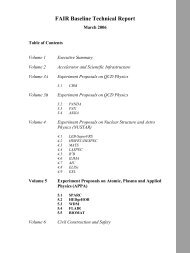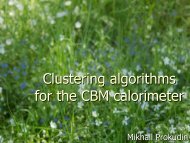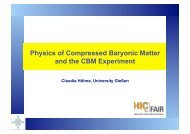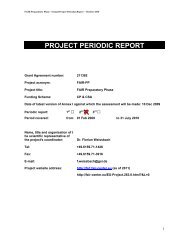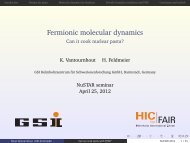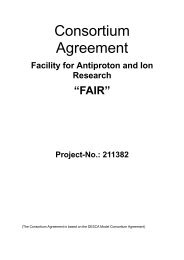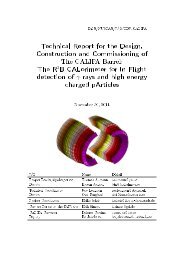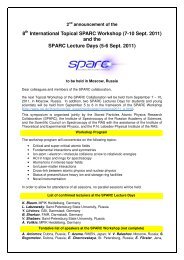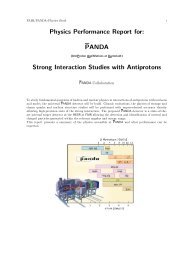NeuLAND - FAIR
NeuLAND - FAIR
NeuLAND - FAIR
Create successful ePaper yourself
Turn your PDF publications into a flip-book with our unique Google optimized e-Paper software.
events<br />
300<br />
200<br />
100<br />
σt=0<br />
σt=100ps<br />
σ<br />
=150ps<br />
t<br />
0<br />
0 0.1 0.2 0.3<br />
Erel<br />
(MeV)<br />
Figure 4.9.: Study of the effect of timing properties of <strong>NeuLAND</strong> on the resolution of<br />
relative energy distributions, simulated using R 3 BRoot. Relative energy<br />
spectra are shown for an ideal time resolution (dashed blue line), σt = 100 ps<br />
(solid blue line), and σt = 150 ps (solid red line). One-neutron events were<br />
emitted from 132 Sn with Erel = 100 keV at 600 AMeV. <strong>NeuLAND</strong> was<br />
located at a distance of 35 m to the target, the scintillator cross section of<br />
5×5 cm 2 was adopted.<br />
The detector depth plays am important role for the efficiency of one- and more-neutron<br />
events. The neutron recognition and its consequences with respect to the final detector<br />
depth were investigated carefully in simulations, which are presented in section 4.5.<br />
4.4. Light-Transport Simulations<br />
In fast scintillator materials the time resolution is given by the number of photons and<br />
their arrival time distribution at the photomultiplier. In this section we investigate the<br />
effect of light guides which serve for the coupling between the quadratic cross section<br />
of the scintillator of 5 × 5 cm to the circular entrance window of the photomultiplier.<br />
Diameters of 1 and 1.5 inch were considered for the photomultiplier entrance window.<br />
For the simulations the optical photon process of GEANT4 was used which allows the<br />
definition of scintillation materials, including their properties like scintillation photon<br />
48





